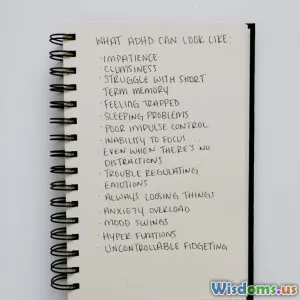
How Dreams Influence Our Thoughts
8 min read Explore how dreams shape our thoughts through brain science insights, revealing their impact on creativity, problem-solving, and emotional processing. (0 Reviews)
How Dreams Influence Our Thoughts: Insights from Brain Science
Dreams have fascinated humanity for millennia, serving as a portal into our subconscious minds. But beyond their enigmatic allure, dreams play a crucial role in shaping our waking thoughts, influencing creativity, decision-making, and emotional processing. Leveraging recent advances in brain science, researchers are unraveling how these nightly experiences impact cognitive function, offering tantalizing insights into the complex dialogue between dreams and our conscious minds.
The Science of Dreaming: A Brief Overview
Dreaming primarily occurs during the rapid eye movement (REM) phase of sleep, characterized by heightened brain activity similar to wakefulness. Neuroscientists have identified that during REM, the limbic system, which regulates emotions, lights up alongside regions responsible for visual imagery and memory, while the prefrontal cortex—responsible for logical reasoning—is comparatively subdued. This unique brain state fosters bizarre, vivid, and emotionally charged dreams, providing fertile ground for subconscious processing.
Dreams as a Catalyst for Creative Thinking
Many legendary thinkers and artists have attributed their breakthroughs to insights derived from dreams. For example, chemist August Kekulé famously dreamed of a snake biting its own tail, inspiring the ring structure of the benzene molecule. Neuroscientific research supports the notion that dreams facilitate creative problem-solving by allowing the brain to form novel associations.
A 2019 study published in Nature Communications showed that during REM sleep, the brain increases the connectivity between distant neural networks, enabling unconventional links between ideas. This neural flexibility means that dreaming may help bypass mental blocks encountered during conscious thought, giving rise to innovative solutions.
Emotional Regulation and Dreaming
Dreams also play an integral role in emotional health by allowing the brain to process and integrate disruptive emotions. Clinically, repeated nightmares or impaired dreaming have been linked to conditions like PTSD and anxiety disorders. Neuroscientist Matthew Walker explains in his book Why We Sleep that REM sleep facilitates downscaling of emotional memories by decoupling the emotional charge from those memories.
For instance, if you faced a stressful event, dreaming helps your brain recontextualize the experience, diminishing its emotional intensity overnight. This emotional detox enhances psychological resilience, enabling more balanced and rational thoughts upon waking.
Problem-Solving Through Dream Incubation
Dream incubation, or deliberately focusing on problems before sleep to seek solutions through dreams, leverages the brain's subconscious processing. Historical records mention figures like Thomas Edison and Salvador Dalí who practiced techniques to harvest creative ideas from dreams.
Modern experiments have substantiated this: participants instructed to concentrate on a problem before sleeping showed significantly better solutions performance compared to controls. The brain, in its dream state, explores diverse strategies unconstrained by objective logic, often generating novel perspectives.
Impact on Memory Consolidation and Learning
The consolidation of memories during sleep not only solidifies learning but also reshapes information, influencing thought patterns. Dreams may represent the brain's effort to integrate new memories with existing knowledge schemas.
Research by psychologist Robert Stickgold has found that the content of dreams often includes elements related to recent learning, supporting the hypothesis that dreaming reflects active memory consolidation. This mechanism strengthens connections between disparate ideas, enriching how we perceive and engage with information daily.
Cultural and Personal Perspectives on Dream Influence
Across cultures, dreams hold profound significance—often seen as messages, prophecies, or reflections of inner desires. While scientific understanding frames dreams as a biological phenomenon, their subjective influence on thoughts cannot be overlooked.
Personal dream journals reveal recurring themes impacting decision-making, self-concept, and creative ventures. For example, recurring dreams about failure might lead individuals to confront fears more consciously, altering their waking mindset and behavior.
Practical Tips to Harness Dream Power
- Maintain a Dream Journal: Recording dreams immediately upon waking enhances recall and facilitates reflection on their influence.
- Engage in Dream Incubation: Focus intently on challenges before sleep to invite subconscious insights.
- Prioritize REM Sleep: Good sleep hygiene and adequate rest ensure your brain cycles sufficiently through REM phases, maximizing dream benefits.
- Practice Mindfulness: Enhances awareness of thoughts, allowing integration of dream insights into daily decisions.
Conclusion: Bridging Dreams and Waking Thought
While dreams may appear ephemeral and nonsensical, brain science reveals their profound import in shaping how we think. By promoting creativity, resolving emotional conflicts, consolidating memories, and enabling problem-solving, dreams act as a vital interface between unconscious processing and conscious thought.
Embracing the insights offered by our dreams offers not just a window into our inner psyche but a valuable tool for personal growth and mental agility. As we continue to demystify the sleeping brain, the tantalizing prospect arises that we can harness dreaming’s power to transform how we think, innovate, and feel—turning nightly journeys into waking wisdom.
References:
- Walker, M. (2017). Why We Sleep: Unlocking the Power of Sleep and Dreams. Scribner.
- Stickgold, R. (2005). Sleep-dependent memory consolidation. Nature, 437(7063), 1272–1278.
- Cai, D. J., Mednick, S. A., Harrison, E. M., Kanady, J. C., & Mednick, S. C. (2009). REM, not incubation, improves creativity by priming associative networks. Proceedings of the National Academy of Sciences, 106(25), 10130–10134.
- Nielsen, T., & Levin, R. (2007). Nightmares: a new neurocognitive model. Sleep Medicine Reviews, 11(4), 295–310.
- Kounios, J., & Beeman, M. (2014). The Eureka Factor: AHA Moments, Creative Insight, and the Brain. Random House.
Rate the Post
User Reviews
Popular Posts





















